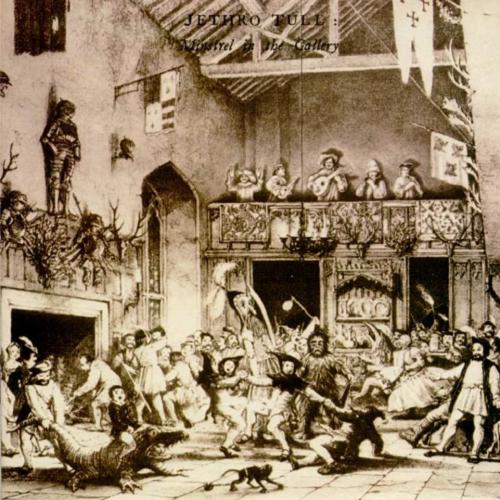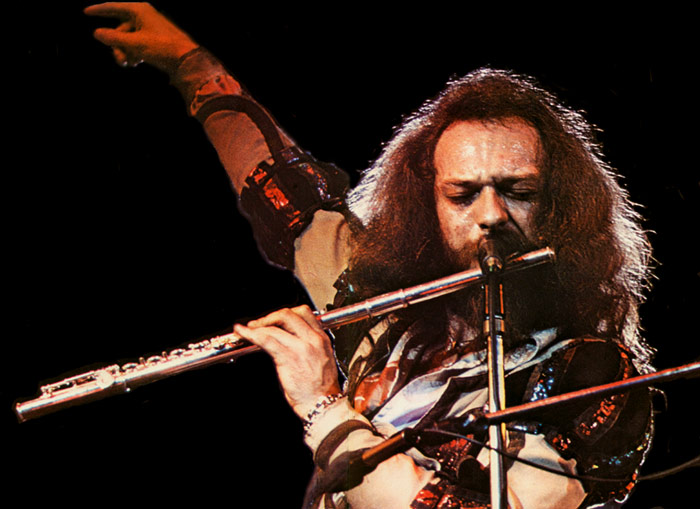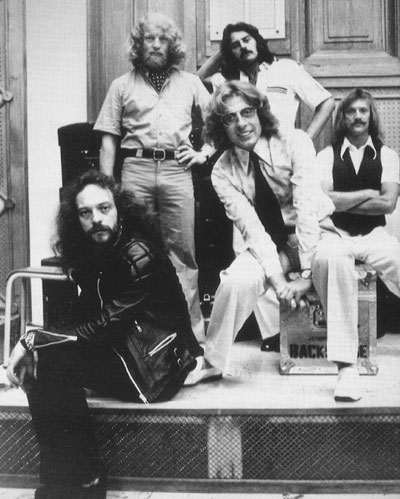Post by Mark Lavallee on Sept 1, 2012 22:22:26 GMT -5
We've arrived in '75 (hey it rhymes!) with my personal favorite album...
Minstrel In The Gallery.

Released on September 5th in the UK where it peaked at a lowly #20, and three days later it came out in the US where it reached a respectable #7 on Billboard's Top Albums Chart. While the albums weren't charting quite as high as before Tull were still most definitely at the peak of their popularity. They sold out 5 nights at the 20,000 seat Inglewood Forum and the enormity of the venues they were playing had the band introducing the concept of giant screens at their concerts, termed Tull-A-Vision. Indeed Melody Maker ran an article headlined "Jethro - Now The World's Biggest Band."

This is the "hardcore" Jethro Tull fan's favorite album along with A Passion Play. This album is more accessible than A Passion Play by far of course, though it does also include a nearly 17 minute epic multi-part song. Lyrically it is a very dark album - introspective and cynical. Anderson had just come out of a divorce and add to that the critical drubbing the band took after A Passion Play and the failure of Anderson's War Child film to get off the ground and it's easy to understand why.

Side A opens with the classic title track. At first sign it is deceptively a folk number, oh but that will quickly change (well 2 minutes in) and Martin Barre comes in with an incredible guitar intro and we're firmly in hard rock territory for the remainder of the track. There's a reason this was a live staple for ages. (Indeed it was the ONLY song from the album played on the tour! everal others made their live debuts in later years) The sound on this album is wonderful, incredible guitar tones, the drum sound is top notch, vocals crystal clear, and the flute, bass, and keys are heavenly. It doesn't get better than this. The musical contrast here shows Anderson's compositional genius. Lyrically the song is very deep, a singer (errr.. I mean, "Minstrel") looking over at his audience and not liking what he sees, but in the end coming to the realization that he's no different from them.
Next up is one of my personal favorites, "Cold Wind To Valhalla." Another one that starts out deceptively acoustic and then morphs into one of the hardest rocking songs the band ever did. Lyrically foretelling the direction the band would take in a couple
years. Perfection.
The next three songs on the album are very personal, bleak portraits of Ian's troubled life at the time. "Black Satin Dancer," a
simple song with only 12 lines, however lyrical analysis shows a portrait of a couple acknowledging what they're losing, having
sex for one last time, and seeing the beauty in each other anew before parting ways. Heavy stuff. There are many mood changes in the piece, with beautiful string arrangements from David Palmer here (and on every song of the album, the unsung hero of the band truly). At the two minute mark the song picks up pace and an incredible guitar solo from Martin Barre comes in before another mood change - the song constantly shifting mood and time signatures. Brilliant work, in the end it explodes into another hard rock masterpiece.
Side A concludes with the beautiful, "Requiem." A requiem for a relationship that has come to an end. Deceptively tender and
beautiful (those strings again), only upon further analysis do you realize how heartbreaking the song truly is. In the first verse drawing upon images from nature as a metaphore for how vulnerable we are and nature's cruel violence. The second verse is the most blatant telling of the end of the relationship. The song's concluding verse brings things around with the bird reference and the unwillingness to enter another relationship out of fear of it failing again. This is truly a beautiful piece of work.
Side B opens with my favorite song on the album, "One White Duck/0/10 = Nothing at All." Continuing the theme from the previous two songs, here Anderson takes the blame for the dissolution of his marriage, "And my zero to your power of ten equals nothing at all," is a portrait of always being away on the road and only having postcards to keep in touch. The 'One White Duck' of the title refers to a traditional northern English wall decoration of three ducks signifying a stable family, the marriage having dissolved leaving the 'One White Duck.'
Next up is the album's centerpiece, the 17 minute epic, "Baker Street Muse." An observation of Anderson's time living in London in the Baker Street area, with allusions to his pursuit of a lady. Full of vibrant imagery to illustrate his own emotional condition lyrically harking back to the Aqualung album with tunes like Mother Goose and Up The Pool. The hysterically pornographic, "Pig Me And The Whore," segment of the song is a highlight. Like A Passion Play the song is far too complex to fully
appreciate without giving it the full attention it deserves, in turn the piece is endlessly rewarding if that time and attention is given. To single out any one musician here would be doing a disservice to the rest of the band. Brilliant stuff.
The album concludes with the 37 second coda, "Grace," a simple sentiment of waking up and looking out the window, but Anderson couldn't resist one last cynical dig at the end. LOL
The remaster of the album adds 5 great bonus tracks. The great B side of the Minstrel single, "Summerday Sands." Thematically, it wouldn't have fit on the album so I can see why it didn't make the cut, but thankfully it didn't languish in the vault because it is truly a great song.
Next up are two songs from the Ring Out, Solstice Bells EP (the title track of which is on Songs From The Wood and the fourth track was the much earlier previously released, "Christmas Song.") "March The Mad Scientist," under two minutes, recorded during sessions for Songs From The Wood, why it didn't make the album I don't know because it would have fit perfectly, musically and thematically. A beautiful piece. Next is the instrumental, "Pan Dance," written for the Top Of The Pops female dance troup Pan's People for their appearances with Tull in 1974. The album concludes with portions (why only the acoustic bits!?!) of the BBC sessions for, "Misntrel In The Gallery," and, "Cold Wind To Valhalla."
boNCw~~_35.JPG)
Up next, it's concept album time again, and another ambitious project meets it's doom with the very polarizing Too Old To Rock 'n' Roll: Too Young To Die!
Final rating - 5 out of 5 stars, it really is that good.
Minstrel In The Gallery.

Released on September 5th in the UK where it peaked at a lowly #20, and three days later it came out in the US where it reached a respectable #7 on Billboard's Top Albums Chart. While the albums weren't charting quite as high as before Tull were still most definitely at the peak of their popularity. They sold out 5 nights at the 20,000 seat Inglewood Forum and the enormity of the venues they were playing had the band introducing the concept of giant screens at their concerts, termed Tull-A-Vision. Indeed Melody Maker ran an article headlined "Jethro - Now The World's Biggest Band."

This is the "hardcore" Jethro Tull fan's favorite album along with A Passion Play. This album is more accessible than A Passion Play by far of course, though it does also include a nearly 17 minute epic multi-part song. Lyrically it is a very dark album - introspective and cynical. Anderson had just come out of a divorce and add to that the critical drubbing the band took after A Passion Play and the failure of Anderson's War Child film to get off the ground and it's easy to understand why.

Side A opens with the classic title track. At first sign it is deceptively a folk number, oh but that will quickly change (well 2 minutes in) and Martin Barre comes in with an incredible guitar intro and we're firmly in hard rock territory for the remainder of the track. There's a reason this was a live staple for ages. (Indeed it was the ONLY song from the album played on the tour! everal others made their live debuts in later years) The sound on this album is wonderful, incredible guitar tones, the drum sound is top notch, vocals crystal clear, and the flute, bass, and keys are heavenly. It doesn't get better than this. The musical contrast here shows Anderson's compositional genius. Lyrically the song is very deep, a singer (errr.. I mean, "Minstrel") looking over at his audience and not liking what he sees, but in the end coming to the realization that he's no different from them.
Next up is one of my personal favorites, "Cold Wind To Valhalla." Another one that starts out deceptively acoustic and then morphs into one of the hardest rocking songs the band ever did. Lyrically foretelling the direction the band would take in a couple
years. Perfection.
The next three songs on the album are very personal, bleak portraits of Ian's troubled life at the time. "Black Satin Dancer," a
simple song with only 12 lines, however lyrical analysis shows a portrait of a couple acknowledging what they're losing, having
sex for one last time, and seeing the beauty in each other anew before parting ways. Heavy stuff. There are many mood changes in the piece, with beautiful string arrangements from David Palmer here (and on every song of the album, the unsung hero of the band truly). At the two minute mark the song picks up pace and an incredible guitar solo from Martin Barre comes in before another mood change - the song constantly shifting mood and time signatures. Brilliant work, in the end it explodes into another hard rock masterpiece.
Side A concludes with the beautiful, "Requiem." A requiem for a relationship that has come to an end. Deceptively tender and
beautiful (those strings again), only upon further analysis do you realize how heartbreaking the song truly is. In the first verse drawing upon images from nature as a metaphore for how vulnerable we are and nature's cruel violence. The second verse is the most blatant telling of the end of the relationship. The song's concluding verse brings things around with the bird reference and the unwillingness to enter another relationship out of fear of it failing again. This is truly a beautiful piece of work.
Side B opens with my favorite song on the album, "One White Duck/0/10 = Nothing at All." Continuing the theme from the previous two songs, here Anderson takes the blame for the dissolution of his marriage, "And my zero to your power of ten equals nothing at all," is a portrait of always being away on the road and only having postcards to keep in touch. The 'One White Duck' of the title refers to a traditional northern English wall decoration of three ducks signifying a stable family, the marriage having dissolved leaving the 'One White Duck.'
Next up is the album's centerpiece, the 17 minute epic, "Baker Street Muse." An observation of Anderson's time living in London in the Baker Street area, with allusions to his pursuit of a lady. Full of vibrant imagery to illustrate his own emotional condition lyrically harking back to the Aqualung album with tunes like Mother Goose and Up The Pool. The hysterically pornographic, "Pig Me And The Whore," segment of the song is a highlight. Like A Passion Play the song is far too complex to fully
appreciate without giving it the full attention it deserves, in turn the piece is endlessly rewarding if that time and attention is given. To single out any one musician here would be doing a disservice to the rest of the band. Brilliant stuff.
The album concludes with the 37 second coda, "Grace," a simple sentiment of waking up and looking out the window, but Anderson couldn't resist one last cynical dig at the end. LOL
The remaster of the album adds 5 great bonus tracks. The great B side of the Minstrel single, "Summerday Sands." Thematically, it wouldn't have fit on the album so I can see why it didn't make the cut, but thankfully it didn't languish in the vault because it is truly a great song.
Next up are two songs from the Ring Out, Solstice Bells EP (the title track of which is on Songs From The Wood and the fourth track was the much earlier previously released, "Christmas Song.") "March The Mad Scientist," under two minutes, recorded during sessions for Songs From The Wood, why it didn't make the album I don't know because it would have fit perfectly, musically and thematically. A beautiful piece. Next is the instrumental, "Pan Dance," written for the Top Of The Pops female dance troup Pan's People for their appearances with Tull in 1974. The album concludes with portions (why only the acoustic bits!?!) of the BBC sessions for, "Misntrel In The Gallery," and, "Cold Wind To Valhalla."
Up next, it's concept album time again, and another ambitious project meets it's doom with the very polarizing Too Old To Rock 'n' Roll: Too Young To Die!
Final rating - 5 out of 5 stars, it really is that good.


